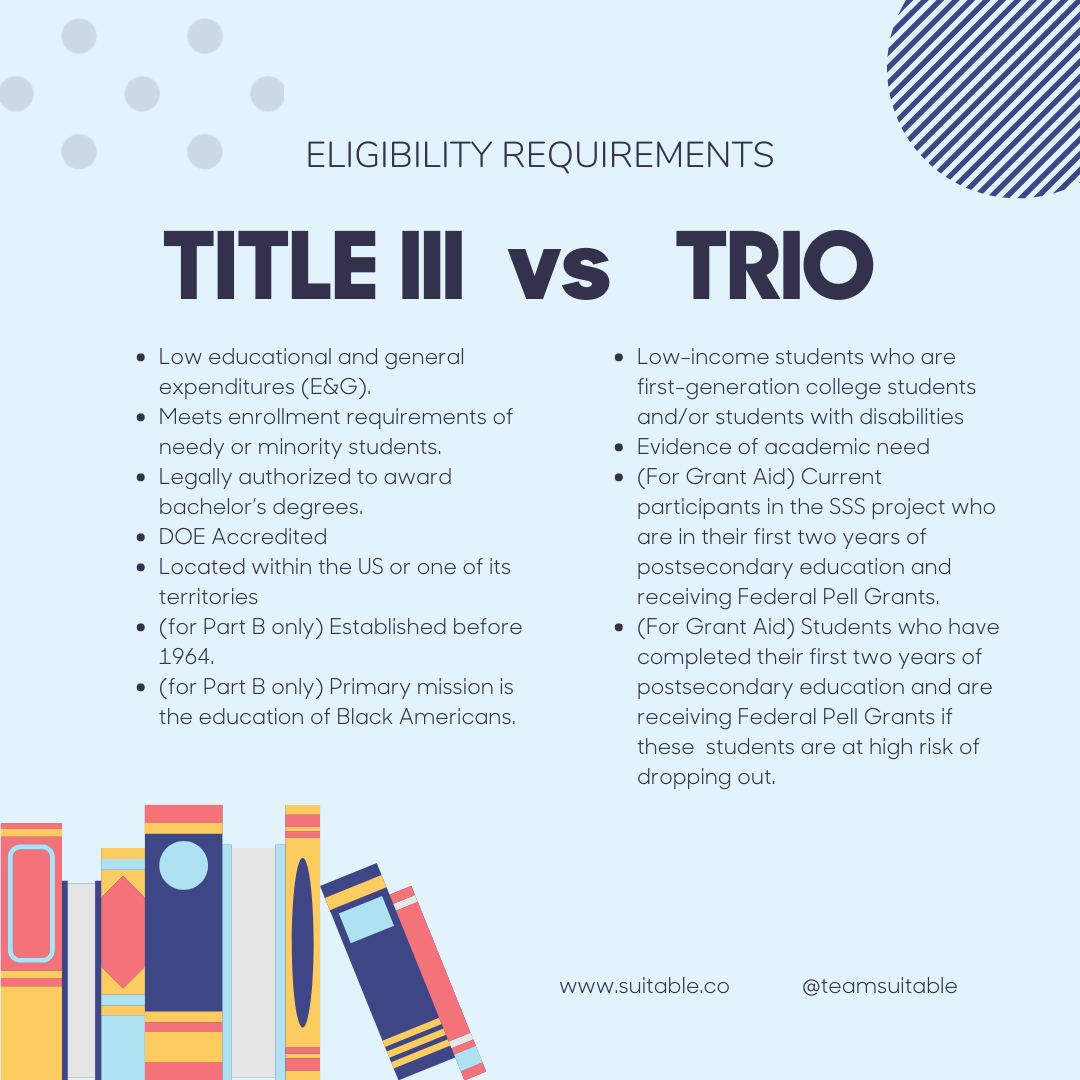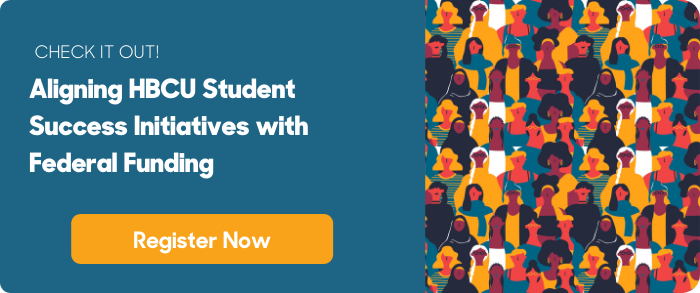
Contents
- What Type Of Funding Do You Need?
- What Is Title III?
- What Is TRIO?
- How To Choose Which Grants To Use
From short-term funds available in response to the pandemic to historic funding programs dating back decades, there is a lot of federal funding universities can access--if they know where to look.
Funding programs have different application criteria with different levels of complexity.
For shorter-term projects, the Pandemic has created a number of new funding initiatives. But depending on the project, short-term funding may not make sense.
If your school has a significant number of underprivileged or protected-class students, there are historic funding programs with long histories of investment in America’s colleges and universities. This article will review two of the most common programs our partners use to pay for Suitable. Find out the difference between them and which might work best for your school.
What Type of Funding Do You Need?
Project Type
Certain projects are more well-suited to receive funding from these programs than others. Deciding which project or program you plan to build is the first step in deciding which federal funding program may apply.
In the case of Suitable, our partners who have accessed federal funding have proposed building student success initiatives and used federal funding either to pay for a limited pilot program using Suitable, or to purchase Suitable, working with our team to create a more holistic implementation.
Short-Term vs. Long-Term
Another determining factor in choosing your federal funding program is whether your funding needs are short-term or long-term.
CARES and other pandemic funds will go away sooner than other long-term funding programs. It is the longer term funding programs like Title III and TRIO that we’ll examine here.
In certain circumstances however, short-term funding may make sense. For example, if you want to run a short pilot program and you think you can make the necessary case for expansion with 1-2 years of data, accessing short-term funding through CARES, CRSSA or ARPA may work for your school.
In other cases, you may be working on an eligible program and applied for a grant or federal funding program that has not come through yet. To bridge this gap, shorter-term funding programs--especially as our education system recovers from a global pandemic--can be very helpful.
If however you are looking to make longer-term, more foundational changes, longer-term funding will ensure that you can prove your program’s effectiveness with a larger data set.
Another area where longer-term funding makes more sense is when your program will concern more than one department. As student success initiatives increase in complexity, having robust data sets over longer periods of time become more and more important and you’ll want to avoid the data interruption of having to re-fund initiatives in just a few years.
Lastly, to truly see the impact of products like Suitable, it is often important to see their effectiveness across all 4 years of a student’s tenure with your university. That way, you can compare success rates before and after implementation, as well as a full college term with the technology as well as without.
So just what are these longer-term, historically significant federal funding initiatives, and how can they help fund your next student success initiative?
What is Title III?
Title III is federal funding for HBCUs and other universities with higher-than-average rates of needy and/or minority students. This funding ensures they have equal access to resources for students. Title III was established in 1966 and, like most bills that old, it has been amended and added to six times. But because not all these additions apply to student success initiatives, we really only need to focus on the first two.
Title III Part A authorizes the Strengthening Institutions Program, which provides grants to institutions with financial limitations and a high percentage of needy students. Title III-A also authorizes separate similar programs for American Indian tribally controlled colleges and universities; Alaska Native and Native Hawaiian-serving institutions; predominantly Black institutions (PBIs); Native American-serving, nontribal institutions; and Asian American and Native American Pacific Islander-serving institutions. Grants awarded under these programs assist eligible institutions in strengthening their academic, administrative, and fiscal capabilities. This phrase “strengthening” is important as this is how many schools make the case for technology purchases and other resources designed to aid student success.
Title III Part B authorizes the Strengthening Historically Black Colleges and Universities (HBCUs) program and the Historically Black Graduate Institutions program, both of which award grants to eligible institutions to assist them in strengthening their academic, administrative, and fiscal capabilities.
History of Title III
Title III, cited as the Adult Education Act of 1966, stated that supplementary educational centers and services would receive funding for additional support services to bolster school attendance. In addition, Title III mandated educational programming even when school was not in session, and it provided for special education and related services in isolated or rural areas. An amendment to the act in 1968 provided the basis for The Bilingual Education Act and the Education of the Handicapped Act.
Title III also explained the need to support Historically Black Colleges & Universities, as well as American Indian tribally controlled colleges and universities; Alaska Native and Native Hawaiian-serving institutions; predominantly Black institutions (PBIs); Native American-serving, nontribal institutions; and Asian American and Native American Pacific Islander-serving institutions; and defined which universities qualify for Title III funds. It is the first two sections (Part A & B) that define Title III eligibility.
Traits of eligible universities
Title III provides discretionary grants that provide formula-based awards to institutions of higher education that must be legally designated as Title III-eligible colleges and universities to apply for funding. Eligible Institutions must meet the criteria below:
Title III Part A
- Has low educational and general expenditures (E&G).
- Has a requisite enrollment of needy students.
- Is legally authorized within its respective state to award bachelor’s degrees.
- Is a junior or community college OR is accredited or pre-accredited by a Department of Education (ED)-recognized national or state accrediting agency.
- Is located within one of the 50 states, the Commonwealth of Puerto Rico, the District of Columbia, or the outlying areas.
Title III Part B
- Established before 1964.
- Has a primary mission that was, and is, the education of Black Americans.
- Is accredited or preaccredited by an ED-recognized accrediting agency.
What Is TRIO?
The Federal TRIO Programs (TRIO) are Federal outreach and student services programs designed to identify and provide services for individuals from disadvantaged backgrounds.
History of TRIO
As a part of Lyndon Johnson's War On Poverty, the Economic Opportunity Act of 1964 introduced a whole host of new initiatives, government offices and grants designed to, among other things, increase access to education for disadvantaged populations.
Upward Bound
It began with Upward Bound, a community-based program for high school students to expose low income, first generation and underrepresented students and students with disabilities to college-access opportunities and they do that by giving grants to colleges and universities and sometimes community non-profits--expose them to college, help them with college prep, that kinda thing. There are specific Upward Bound program types for things like STEM and Math & Science and students who want to pursue education.
Talent Search
Like Upward Bound for Middle School Students. Talent Search was created as part of the Higher Education Act of 1965. It is much less personalized, and at a much larger scale--doing 'college prep' for 6-700 students at a time versus an Upward Bound councilor might only have 50-100 students participate at a time.
Special Services
Now called Student Support Services (SSS), this program was introduced as an amendment in 1968. SSS is a retention program inside of colleges and universities. Our partner, Jackson State University, has two of them.
By the late 60s, these three core programs were being called TRIO.
Ronald E. McNair Postbaccalaureate Achievement
Through a grant competition, funds are awarded to institutions of higher education to prepare eligible participants for doctoral studies through involvement in research and other scholarly activities. Participants are from disadvantaged backgrounds and have demonstrated strong academic potential. Institutions work closely with participants as they complete their undergraduate requirements. Institutions encourage participants to enroll in graduate programs and then track their progress through to the successful completion of advanced degrees. The goal is to increase the attainment of Ph.D. degrees by students from underrepresented segments of society.
Veterans Upward Bound
Through a grant competition, funds are awarded to institutions of higher education to prepare eligible participants for doctoral studies through involvement in research and other scholarly activities. Participants are from disadvantaged backgrounds and have demonstrated strong academic potential. Institutions work closely with participants as they complete their undergraduate requirements. Institutions encourage participants to enroll in graduate programs and then track their progress through to the successful completion of advanced degrees. The goal is to increase the attainment of Ph.D. degrees by students from underrepresented segments of society.
Traits of eligible universities (by TRIO category)
Eligibility is based on who is going to use the program and what TRIO funding the school is seeking. Schools apply for funding on behalf of students who gain eligibility by enrolling and being accepted into eligible programs.
Retention is a metric that will be used to measure success. If your school is focusing on retention for qualifying students, this will help you gain eligibility.
Participant Eligibility for Program Services
To receive assistance, students must be enrolled or accepted for enrollment in a program of postsecondary education at a grantee institution. Low-income students who are first-generation college students and students with disabilities evidencing academic need are eligible to participate in SSS projects. Two-thirds of the participants in any SSS project most be either disabled or potential first-generation college students from low-income families. One-third of the disabled participants must also be low-income students.
Participant Eligibility for Grant Aid
To receive SSS program grant aid, students must be current participants in the SSS project who are in their first two years of postsecondary education and receiving Federal Pell Grants.
Grant aid may be offered to students who have completed their first two years of postsecondary education and are receiving Federal Pell Grants if the institution demonstrates that these students are at high risk of dropping out and it has first met the needs of all its eligible first and second-year students.
How To Choose Which Grants To Use
Set Program Goals
The best place to start when deciding which grant to choose is to start at the end--what do you want your new technology or student engagement program to help you achieve? If it's retention, TRIO funding through the SSS program may make the most sense. If it is strengthening and measuring student progress towards advanced degrees, the McNair Postbaccalauriette program will be the place to go. If your goal is to strengthen the campus experience for all students, Title III funds are available for schools with certain levels of disadvantaged population.
Set Program Scope
Do you want to build a program for one college or something more overarching? This decision could change what grant funding you use. For example, some schools may find they want to purchase new technology only for one college or program within their school in order to pilot the program. While short-term funds can be used for pilot programs, some university administrators may opt for longer-term pilot program timelines that may require or invite longer-term funds. So if your university is eligible and you want to create a Suitable implementation into a program that is not a TRIO-eligible program, Title III funds can help with that particular program scope. In cases like this, your school may be able to access TRIO funds as well once the program expands to other, TRIO-eligible programs.
Permanency
Even if your school is not Title III eligible, short-term funding programs like CARES provide a good opportunity to pilot new technology. If you want something more permanent, using programs like Title III, where grants only need to be reapplied every 5 years, will work better. In either case, you will have to provide data to support renewal so it is best to work with a technology that will help you in the handling of complex student engagement data sets.
Knowing your federal funding programs can help you stand out at your university. It allows you to take every advantage afforded to your university and accomplish the impactful initiatives that get noticed.
To learn more about how to get internal buy-in and how to build your next student success initiative to scope that will qualify for these funds, join us on September 30th, where Dr. Loria Gordon from Jackson State University will take us through how she used Title III funds to purchase Suitable for their Honors Experience program.


-1.png)

